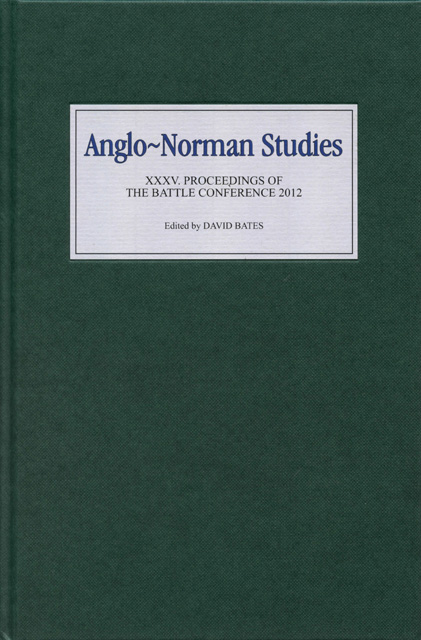Book contents
- Frontmatter
- Dedication
- Contents
- List of Illustrations and Tables
- Editor’s Preface
- Abbreviations
- A Three-Cornered Dynamic of Redemption in the ‘Long’ Thirteenth Century: Villein Manumissions and the Theology of the Incarnation (The R. Allen Brown Memorial Lecture, 2011)
- Femmes en religion, personnes d’autorité: les abbesses normandes (XIe–XIIIe siècles) (The R. Allen Brown Memorial Lecture, 2012)
- The Role of the Curator of the Bayeux Tapestry
- Early Normandy
- The Norman Conquest, Countess Adela, and Abbot Baudri
- Baldric of Bourgueil and the Flawed Hero
- John Bilson (1856–1943) and the Study of Anglo-Norman Romanesque
- The Identity of the Designer of the Bayeux Tapestry
- The Pseudo-Hugh Falcandus in His Own Texts
- The Thirteenth-Century Chronique de Normandie
- Les investitures abbatiales en Normandie: quelques réflexions autour du cas de l’abbaye du Bec-Hellouin (1034–1136)
- Robert Curthose: The Duke Who Lost His Trousers
- Sufficientia: A Horatian Topos and the Boundaries of the Self in Three Twelfth-Century Poems
- Aristocratic Acta in Normandy and England, c. 1150–c. 1250: The Charters and Letters of the Du Hommet Constables of Normandy
- Crime without Punishment: Medieval Scottish Law in Comparative Perspective
- Landscape and Belief in Anglo-Norman England
- Contents of Volumes 1–34
Robert Curthose: The Duke Who Lost His Trousers
Published online by Cambridge University Press: 28 February 2023
- Frontmatter
- Dedication
- Contents
- List of Illustrations and Tables
- Editor’s Preface
- Abbreviations
- A Three-Cornered Dynamic of Redemption in the ‘Long’ Thirteenth Century: Villein Manumissions and the Theology of the Incarnation (The R. Allen Brown Memorial Lecture, 2011)
- Femmes en religion, personnes d’autorité: les abbesses normandes (XIe–XIIIe siècles) (The R. Allen Brown Memorial Lecture, 2012)
- The Role of the Curator of the Bayeux Tapestry
- Early Normandy
- The Norman Conquest, Countess Adela, and Abbot Baudri
- Baldric of Bourgueil and the Flawed Hero
- John Bilson (1856–1943) and the Study of Anglo-Norman Romanesque
- The Identity of the Designer of the Bayeux Tapestry
- The Pseudo-Hugh Falcandus in His Own Texts
- The Thirteenth-Century Chronique de Normandie
- Les investitures abbatiales en Normandie: quelques réflexions autour du cas de l’abbaye du Bec-Hellouin (1034–1136)
- Robert Curthose: The Duke Who Lost His Trousers
- Sufficientia: A Horatian Topos and the Boundaries of the Self in Three Twelfth-Century Poems
- Aristocratic Acta in Normandy and England, c. 1150–c. 1250: The Charters and Letters of the Du Hommet Constables of Normandy
- Crime without Punishment: Medieval Scottish Law in Comparative Perspective
- Landscape and Belief in Anglo-Norman England
- Contents of Volumes 1–34
Summary
Robert Curthose has been the subject of much recent reassessment. Some of it has questioned how shambolic his reign as duke really was. The purpose of this essay is different, and narrower: to analyse the most detailed, definitive treatment of the reign, in Orderic Vitalis’s Historia Ecclesiastica. I shall not, therefore, attempt to judge how accurate Orderic’s account might have been, but I shall conclude by showing that it was not entirely divorced from reality. Indeed, it was partially grounded in, or at least made congruent with, the official treatment of the reign propounded on behalf of King Henry I after his defeat and effective deposition of Duke Robert in 1106. Orderic did not, however, start with a blank historiographical sheet when he addressed the subject of Curthose in the Historia Ecclesiastica. What has been termed his historical apprenticeship consisted in interpolating William of Jumièges’s Gesta Normannorum Ducum. I therefore turn first to William of Jumièges’s slight treatment of Robert Curthose, because this was Orderic’s starting-point, and because it provides a limited, early bearing on his extensive, later account.
Writing probably in 1070, William of Jumièges’s customary, laconic reticence cracked as he waxed uncharacteristically lyrical about William the Conqueror’s eldest son, Robert. He felt obliged to record what he then considered to be Robert’s very recent promotion as duke in Normandy, a substitution which would allow his father to concentrate henceforth on the newly acquired kingdom of England. William of Jumièges refers to this supposed change in Robert’s status no fewer than three times, although it is striking that he never describes the father, as ruling duke, designating his chosen son as successor, a ceremony which had become so standard by this point in the Gesta’s accounts of the lives of successive dukes that William had devised a formula for it. Regardless of the absence of such an account in Robert’s case, William envisaged that Duke Robert, not King William, would be the subject of his prospective supplement to the Gesta Normannorum Ducum. Events, most spectacularly the conquest of England, had already obliged him to add one sequel to – and probably make several interpolations in – a work which, it has been shown, had originally existed in draft shortly before 1060.
- Type
- Chapter
- Information
- Anglo-Norman Studies 35Proceedings of the Battle Conference 2012, pp. 213 - 244Publisher: Boydell & BrewerPrint publication year: 2013
- 1
- Cited by



